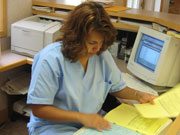   |
|
Bleach Your Teeth Crowns Dental Anesthesia Dental Implants Dentures: Get Your Smile Back Extraction of Wisdom Teeth Flossing Fluoride and Your Health Night Guards/Splints Nutrition & Dental Health Oral Cancers Porcelain Laminate Veneers Pregnancy and Oral Health Root Canal Therapy Temporomandibular Disorders TMJ/TMD The Right Time for Braces Tooth Decay: A Preventable Disease Women's Dental Health Your Child's First Dental Visit Your Child's Teeth and Gums: Tips for Parents |
Why do I need anesthesia at the dental office? To make your dental visit as comfortable as possible, your dentist may suggest anesthesia to reduce or eliminate any pain or anxiety that may be related to your dental treatment. The type of anesthesia required for any dental procedure depends on the needs or preferences of the patient. How do I know if I'm a candidate for dental anesthesia? You and your dentist will decide what level of anesthesia is right for you. Some patients prefer a higher level of anesthesia than others. Children, people with special needs, such as mental retardation, and those with a condition, such as a dental phobia may require a higher level of anesthesia. What are the levels of dental anesthesia? Local anesthesia is produced by the application or injection of a drug to eliminate pain in a specific area in the mouth. Topical anesthetics are frequently used by your dentist to numb an area in preparation for administering an injectable local anesthetic. Injectable local anesthetics, such as Lidocaine, numb mouth tissues in a specific area of your mouth for a short period of time. Your dentist will probably inject a local anesthetic before filling cavities, preparing your teeth for crowns, or for any surgical procedure. Local anesthesia is the most commonly used form of anesthesia in the dental office. Conscious sedation can be used to help you relax during a dental procedure. Your dentist may administer an anti anxiety agent, such as nitrous oxide, or a sedative, in combination with a local anesthetic for pain. During conscious sedation, you will remain calm during treatment, yet rational and responsive to speech and touch. Anti-anxiety agents and sedatives can be administered by mouth, inhalation or injection. Deep sedation and general anesthesia is used for complex procedures and for patients who have trouble controlling their movements or need a deeper level of anesthesia during treatment. During deep sedation you will be unable to respond appropriately to verbal commands. During general anesthesia you will be unconscious. What should I tell my dentist before receiving anesthesia? Your dentist needs to know about all the medications that you are taking, any allergic reactions you've had to medicines in the past, and your past and present health conditions. It's important that you answer your dentist's questions completely and ask about your concerns. This way your dentist will be sure to tell you everything you need to know before receiving treatment. For example, in some cases, your anesthesia treatment may require that you suspend certain medications or abstain from eating or drinking for a period of time before the treatment. Is anesthesia in the dental office safe? Although taking any medication involves a certain amount of risk, the drugs that produce anesthesia are entirely safe when administered by a trained anesthesia provider. The best thing to do is ask questions about any procedure that you are not familiar with. Ask about alternatives, training, the doctor's commitment to continuing education and the credentials of other personnel in the dental office who might be assisting with your treatment. Good communication between the dentist and the patient is the best way of insuring safety. Members of the Academy of General Dentistry (AGD) are required to take 75 hours of continuing dental education every three years to remain in good standing. The AGD Fellowship and Mastership awards reflect additional hours of experience and study. Sources: James Chancellor, DDS, MAGD, "Morbidity and Mortality Associated with the Pharmacologic Management of Pain and Anxiety," Compendium of Continuing Dental Education, Vol. XIV, No.6; "Guidelines for Teaching the Comprehensive Control of Pain and Anxiety in Dentistry," American Dental Association 1992; "Understanding Dental Anesthesia: What Every Patient Should Know, " American Dental Association 1999. This information was compiled for you by the Academy of General Dentistry. Your dentist cares about long-term dental health for you and your family and demonstrates that concern by belonging to the Academy of General Dentistry. As one of the 35,000 general dentists in the United States and Canada who are members of the Academy, your dentist participates in an ongoing program of professional development and continuing education to remain current with advances in the profession and to provide quality patient treatment. Visit the AGD's website at www.agd.org. You have permission to photocopy this page and distribute it to your patients. |
Questions - Comments - Suggestions
Should you have questions about any aspect of dental disease or treatment, or,
have a specific problem or treatment need, contact us at:
Phone: 1.707.255.3007 or E-Mail: dentist@johnsondmd.com
Address: 3434 Villa Lane, Suite #100; Napa, CA. 94558
© Copyright 2007, Thomas C. Johnson, DMD, Inc. All Rights Reserved.
